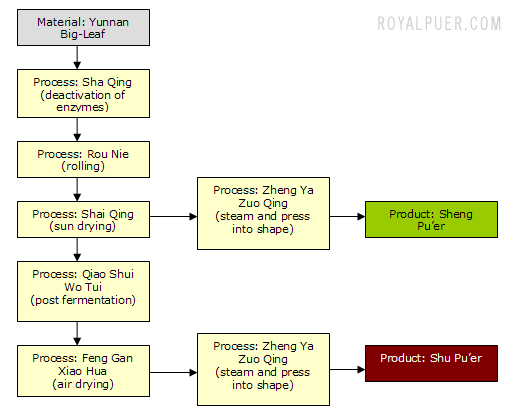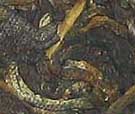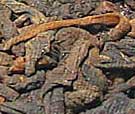Learn More About Pu'er Tea
| 1. | INTRODUCTION TO PU'ER TEA |
|
Pu'er (also spelled as Pu'erh) tea is a category of tea made using the tea leaves picked from
Yunnan big-leaf tea tree species. This is one tea that is truly unique to China and has been around
for more than 1,700 years. It is named after its origin, Pu'er County
in southern Yunnan of China. One of the most beautiful traits of a Pu'er tea is that,
like fine wine, the quality, taste and value improves with age.
Traditionally, Pu'er teas were pressed into various shapes such as round cake and
brick to facilitate trade and transportation. Also, seven of these cakes are usually
packed together in bamboo wrap (known as Qi Zi Bing Cha, or Seven Sons Tea Cake).
Nowadays, the compressed state of Pu'er tea leaves helps to conserve valuable
storage space when Pu'er teas are stored for aging.
As a beverage, Pu'er tea taste and flavor can vary greatly depending on type, grade and age.
Because most people are only exposed to very low grade Pu'er tea served in
Chinese restaurants, Pu'er earned an undeserved reputation of having an unpleasant "earthy" taste.
Good Pu'er teas are wonderfully complex beverage and have a incredibly smooth mouth-feel.
|
|
 Back to top Back to top
|
| |
| 2. | TYPES OF PU'ER TEA |
|
At the highest level, Pu’er can be categorized into two main types:
- Sheng Pu’er (also known as Raw, Uncooked and Green Pu’er)
- Shu Pu’er (also known as Ripe, Cooked and Black Pu’er)
Both Pu’er types are made from the same material (Yunnan Big-Leaf) and go through the same fundamental processes during production. Production of Shu Pu’er however, involves some extra steps as illustrated in the diagram below.

Diagram 1 : Processes involved in production of Sheng and Shu Pu'er
|
The additional steps introduced in the production of Shu Pu’er are meant to accelerate the aging process in order to imitate the highly desired flavor and appearance of aged Sheng Pu’er. This technique was first tested by Kunming Tea Factory before being perfected by Menghai Tea Industry in the 70s. Shu Pu’er was created because there was an over-demand for Pu’er tea at that time. Newly produced and un-aged Sheng Pu’er, while drinkable, can be very astringent and requires several years of aging in order for its flavor and texture to be be improved. Thus, Shu Pu’er was introduced as an instantly ready-for-drinking alternative.
|

Sheng Pu'er Appearance:
Light yellowish buds

Shu Pu'er Appearance:
Reddish buds
|
| |
| In addition to these two main types of Pu’er, there is also a lesser known type called “half-cooked”. This is actually made using a mixture of Sheng and Shu Pu’er tea leaves with the intention of creating a tea that is immediately drinkable, but also partly preserving the ability of the tea to age naturally. |
| |
| Besides Sheng and Shu, Pu’er can also be categorized according to their shapes. There are many various shapes but the most common being: |
- Bing (Round cake)
- Tuo (Bowl shape)
- Zhuan (Brick shape)
|
|
|
 Back to top Back to top
|
| |
| 3. | PU'ER MEDICINAL CLAIMS |
|
Pu'er tea has been revered as a medicinal tea in China for thousand of years. It is generally believed to aid digestion and bowel movements, lowers cholesterol, controls obesity and detoxifies your body. While there is no conclusive evidence to substantiate these claims, many recent scientific studies conducted by Universities, medical and research institutes do support them.
It is worth pointing out that Tibetans living on the cold, high mountains rely mainly on Pu’er Tea Bricks as their source of vitamins and mineral. Many of them are herders and their daily diet consists of high fat and high protein dairy products, meat and wheat. Vegetables and fruits are scarce. Drinking tea helps digestion, and dissolves the high fat and oil intakes. It also provides them with the necessary vitamins and minerals, and cleanses their body from poison accumulated from excessively high dairy and meat intakes.
Note : The medicinal claims provided in RoyalPuer.com do not constitute a representation of any express expert opinion by us but are obtained solely from the findings of researchers and institutions.
|
|
 Back to top Back to top
|
| |
| 4. | GUIDE TO BREWING PU'ER TEA |
|
|
|
|
Step 1
Rinse and pre-heat your tea cup with hot water. |
|
Step 2
Insert tea leaves. If you are unsure of the amount to use, then start with around 2-3 grams for every 100ml of water. Adjust according to your preference (strong or light). |
| |
|
|
|
Step 3
Pour hot water into your tea cup and allow it to steep for 2-3 seconds. |
|
Step 4
Throw away the first infusion. This removes any attaching dusts and residues. |
| |
|
|
|
Step 5
Pour boiling water (98 to 100°c) into your tea cup again. |
|
Step 6
Steep for 1 minute for 1st and 2nd brewings. Gradually increase steeping time by 10-20 seconds for subsequent brewings. |
| |
|
|
|
Step 7
Pour your tea into a pitcher or glass. |
|
Step 8
Your tea is now ready to serve. Enjoy and have a wonderful te |
|
|
 Back to top Back to top
|
| |
| 5. | STORING AND AGING PU'ER TEA |
|
Pu'er is special in that the quality and value improves with age. The older it is, the better.
This is especially true with Sheng Pu'er. After going through the natural post fermentation from years of aging,
this tea develops a very desirable and special kind of taste and fragrance found only in aged Pu'er.
If you are interested in storing and aging your Pu'er, we recommend you choose the compressed type (tea cake, brick, tou cha etc).
It is not difficult to store Pu'er tea at all. Here are a few guidelines :
- Keep away from sunlight and heat.
- Clean and dry environment.
- Keep away from places with strong odors.
- Provides good ventilation. Unlike other types of tea, Pu'er requires ventilation in order to age.
|
|
 Back to top Back to top
|
| |
|
  |  |  |  | Item(s) : 0 | | Your shopping cart is empty |
|
|  |  |  | | |   |  |  | |  |  |  | | |   |  |  | |  |  |  |
|

